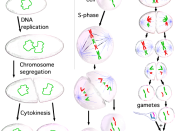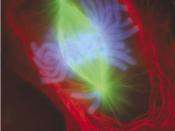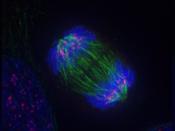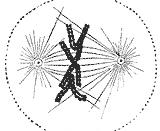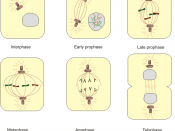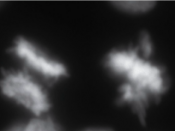Cell division in animals: mitosis, cytokinesis, and the cell cycle.
Cell division in animals is a two-step process involving mitosis and cytokinesis and is set up by interphase.
Interphase is a growth period for the cell. In the nucleus the chromosomes are duplicated but are not yet distinguishable because they are still a form of chromatin. There is also a nucleoli, one or more, present producing ribosomes that are sent to the cytoplasm.
Mitosis is the division of the nucleus and multiplication of the chromosomes. There are four phases of mitosis: "ñ Prophase "ñ Metaphase "ñ Anaphase "ñ Telophase During prophase, the first stage of mitosis, the chromatin fibers coil tightly to form chromosomes. Then the nucleoli disappear when they unravel. The now chromosomes have two sister chromatids that are bonded at a midpoint called the centromere. Mitotic spindles are also formed in the cells cytoplasm during prophase. In the later stages of the first step of mitosis the nuclear envelope breaks apart.
Now that the nuclear envelope is broken up into pieces centrosomes, made in interphase, reposition to the poles of the cell. In the centromere of each chromatid is a point called the kinetochore. Then the spindle microtubules attach to the kinetochore making the chromosomes move. The spindle microtubules shift the chromosomes to the center of the cell.
Metaphase is the second part of mitosis. During metaphase the formation of the mitotic spindles is complete making the cells transition to the polar state finished as well. The chromosomes then line up on an imaginary midpoint called the metaphase plate. Once a part of the metaphase plate the centromeres line up to that the sister chromatids are on adjacent sides of the metaphase plate. The last period of metaphase involves each of the chromatids kinetochoreáæs fastening to a centrosome from opposite poles of the cell.
Then third step in the miotic process is called anaphase. In the early stages of anaphase the centromeres of each sister chromatid come apart forming daughter chromosomes. The now daughter chromosomes are áçwalkedáè up the spindle microtubule, this walking is powered by ATP in the kinetochore. The spindle microtubules that are secured to a kinetochore begin to shorten while the spindle microtubules that arenáæt attached begin to lengthen. The cell then becomes elongated as the poles of the cell become farther apart. When all of the daughter chromosomes have reached the centrosomes at the poles of the cell anaphase is complete.
The fourth and final stage of mitosis is telophase that can be considered the reverse of prophase. Picking up where anaphase left off the cell continues to lengthen. Daughter nuclei begin to re-emerge at the poles of the cell and nuclear envelopes start to form around the chromosomes. Next the chromatin uncoils and the nucleoli return followed by the disappearance of the mitotic spindles. Telophase is completed when two genetically indistinguishable daughter cells are concluded.
Just after mitosis is completed cytokinesis takes place. During cytokinesis the cytoplasm divides and the daughter cells become totally divided with the help of the cleavage furrow that pinches the cell into two.
There are essentially three stages to interphase other than the mitotic phase. The first of these is called G1. G1 is primarily a growth phase with the number of ribosomes, mitchochondira, and other proteins all increasing as the cell gets larger in size. The next step is called the S phase. In the S phase, or synthesis phase, the main function is reproduce DNA and later the chromosomes change into sister chromatids. The last subphase is called G2. G2 is also a growth phase where more proteins are syntheisized in the time between DNA replication and cell division.
